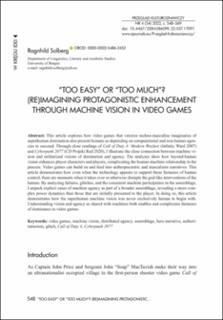| dc.contributor.author | Solberg, Ragnhild | |
| dc.date.accessioned | 2023-03-23T07:24:13Z | |
| dc.date.available | 2023-03-23T07:24:13Z | |
| dc.date.created | 2023-02-02T12:12:21Z | |
| dc.date.issued | 2022 | |
| dc.identifier.issn | 1895-975X | |
| dc.identifier.uri | https://hdl.handle.net/11250/3059992 | |
| dc.description.abstract | This article explores how video games that valorize techno-masculine imaginaries of superhuman domination also present humans as depending on computational and non-human agencies to succeed. Through close readings of Call of Duty 4: Modern Warfare (Infinity Ward 2007) and Cyberpunk 2077 (CD Projekt Red 2020), I illustrate the close connection between machine vision and militarized visions of domination and agency. The analyses show how beyond-human vision enhances player characters and players, complicating the human-machine relationship in the process. Video games can build on and feed into anthropocentric and masculinist narratives. This article demonstrates how even when the technology appears to support these fantasies of human control, there are moments when it takes over or otherwise disrupts the god-like interventions of the human. By analyzing failures, glitches, and the consistent machine participation in the assemblage, I unpack explicit cases of machine agency as part of a broader assemblage, revealing a more complex power dynamics than those that are initially presented to the player. In doing so, this article demonstrates how the superhuman machine vision was never exclusively human to begin with. Understanding vision and agency as shared with machines both enables and complicates fantasies of dominance in video games. | en_US |
| dc.language.iso | eng | en_US |
| dc.publisher | Jagiellonian University Press | en_US |
| dc.rights | Navngivelse 4.0 Internasjonal | * |
| dc.rights.uri | http://creativecommons.org/licenses/by/4.0/deed.no | * |
| dc.title | "Too easy” or “too much”? (Re)imagining Protagonistic Enhancement through Machine Vision in Video Games | en_US |
| dc.type | Journal article | en_US |
| dc.description.version | publishedVersion | en_US |
| cristin.ispublished | true | |
| cristin.fulltext | original | |
| dc.identifier.doi | 10.4467/20843860PK.22.037.17091 | |
| dc.identifier.cristin | 2122282 | |
| dc.source.journal | Przegląd Kulturoznawczy | en_US |
| dc.source.pagenumber | 548-569 | en_US |
| dc.identifier.citation | Przegląd Kulturoznawczy. 2022, 4 (54), 548-569. | en_US |
| dc.source.volume | 4 | en_US |
| dc.source.issue | 54 | en_US |

